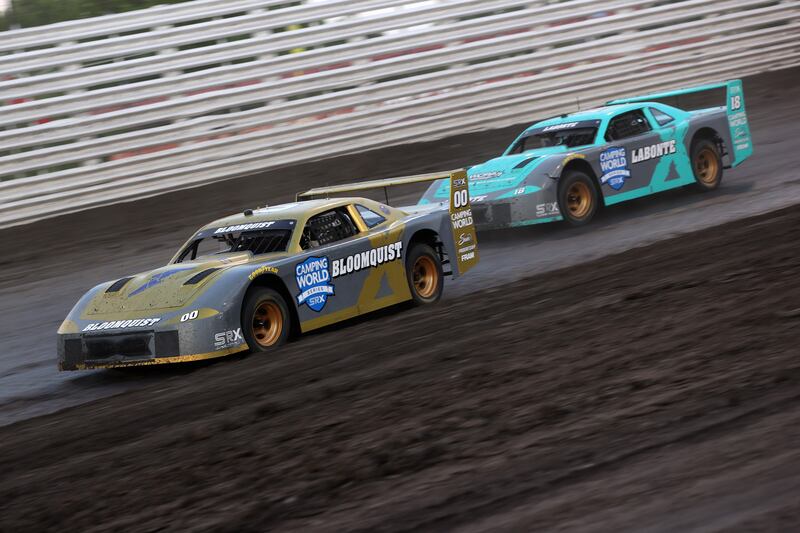The king of the dirt trackers died when he crashed his 1938 Piper Cub plane into a barn on his farm in Mooresburg, Tennessee earlier this month. At 60, Scott Bloomquist won over 600 races with the skull-and-crossbones logo on his car, and was known, cheered and jeered across the American heartland as “Black Sunshine”. With an unshakeable swagger and distinctive flowing locks more befitting the lead singer from some 1980s metal band, he dominated half-mile ovals in evocatively-named venues such as Smoky Mountain, Atomic, Bulls Gap, Green Valley and Eldora. Flawed and fearless, Burt Reynolds’ Bandit made flesh.
“Scott Bloomquist looked like Thor and Fabio mashed into one human,” tweeted Ryan McGee of ESPN upon hearing the news of his death. “I once told him that and he responded, ‘Nah, I don’t look like them. They look like me.’ Godspeed to a genuine first edition American bad ass.”
Bloomquist won so much that his rivals complained he must be tyre doping (treating them with chemicals) and speculated as to just what other nefarious dark magic he performed when working on his self-built vehicles behind protective canopies in the pits. Few knew how to set up a race car better.
And allegations of any stripe against him never bothered the tens of thousands who signed up to join the first dirt track racer’s fan club ever, purchased his merchandise at every track, and swarmed him in victory lane. That his persona, an amalgam of beer, bragging and bravado, often came trailing serious attitude and a whiff of scandal merely added to the allure.
Rugby World Cup draw: When is it, what will it decide, and who might Ireland face?
When is the World Cup draw and who could Ireland meet if they win playoffs?
World Cup playoffs in Prague: Avoid €800 flights with insider tips from an Irish local
From Mike Tyson to Boris Becker and DJ Carey – the best sports books of 2025
“Half of them love me,” he said. “Half of them hate me, but they are all here to see me.”
Bloomquist went to prison in his mid-1990s pomp, and everything about the case dovetailed perfectly with the outlandish narrative of his legend. Thirty-six hours after a storybook wedding to “Miss Motorsports” Midi Miller, agents from the Third Judicial District Drug Task Force stormed his property and arrested him on cocaine-related offences.
Their evidence consisted of suspicions regarding the tiny airstrip on his land, a single piece of straw from his shirt pocket that contained residue of the drug, and tapes of incriminating conversations between himself and a former girlfriend, Kristi Candler. Candler was a stripper at a club in Knoxville who, facing potential jail time for a DUI, agreed to wear a wire and to get Bloomquist to source her coke.
In the ensuing legal drama, Bloomquist won a famous case against the state of Tennessee for entrapment but was found guilty of possession after a second trial. Much to the annoyance of the judge, the sheriff in charge of supervising his custody happened to be a fan, and he put his high-profile prisoner on boutique work release. Checking out of jail at seven each morning, Bloomquist headed home to tinker with his cars before returning for a 9pm curfew. Then there was usually time for pizza and a cosy chat with the guards before hitting the hay. Claiming it was some of the best sleep he’d ever got, he won races nearly every weekend of his sentence.
Sprinkled across mostly flyover states are more than 800 dirt track speedways where amateurs and semi-pros drive cars with no windshields at speeds of up to 150mph (241km/h) as they navigate flying pebbles and compete for five-figure cash prizes. Thirty million fanatical Americans turn out to watch each year but most of their compatriots regard this brand of down-home racing as, at best, a rural curiosity.

Having grown up in California nurturing surfing dreams, Bloomquist was transplanted to the rolling green hills of eastern Tennessee when his father, a commercial pilot, bought a farm there. Initially, he worked the land to fund his nascent driving hobby until it eventually evolved into a lucrative career where he earned millions sliding across mud, dirt and clay all over the midwest.
He once won a race on three working wheels for the last 20 laps, and there was constant speculation about him making the leap to the more mainstream NASCAR circuit. His hirsute outlaw image (witness a pic of him driving a convertible Camaro shirtless that did the rounds last week) would never have fit into that more corporate environment.
“It’s not for me,” he said. “I wouldn’t be very good at being somebody’s poodle.”
Everybody in and around NASCAR knew just how good he was and could have been. Tony Stewart, one of the greatest stock car racers of the modern era, described him as “a force on the track and off”. Last year, Dale Earnhardt Jr treated him with utter reverence on his podcast even as Bloomquist, whose undulating quest for spiritual enlightenment was just another compelling part of his journey, unspooled bizarre yarns about encounters with reptilian aliens lowering their spacecraft to draw water from the lake on his farm.
“Don’t ever get on the cigar-shaped ship,” he advised listeners should they encounter extraterrestrial visitors. “Get on the saucer. Just a little friendly advice.”
Having survived very serious injuries from a 2019 motorcycle crash, and more recently battled prostate cancer, he was long past his best yet still registered to drive at the prestigious world 100 at Eldora next month. Instead, those races will now be preceded by a celebration of his life. It will take place in the home stretch and his number zero car will be parked in the winner’s circle. Where else?
















